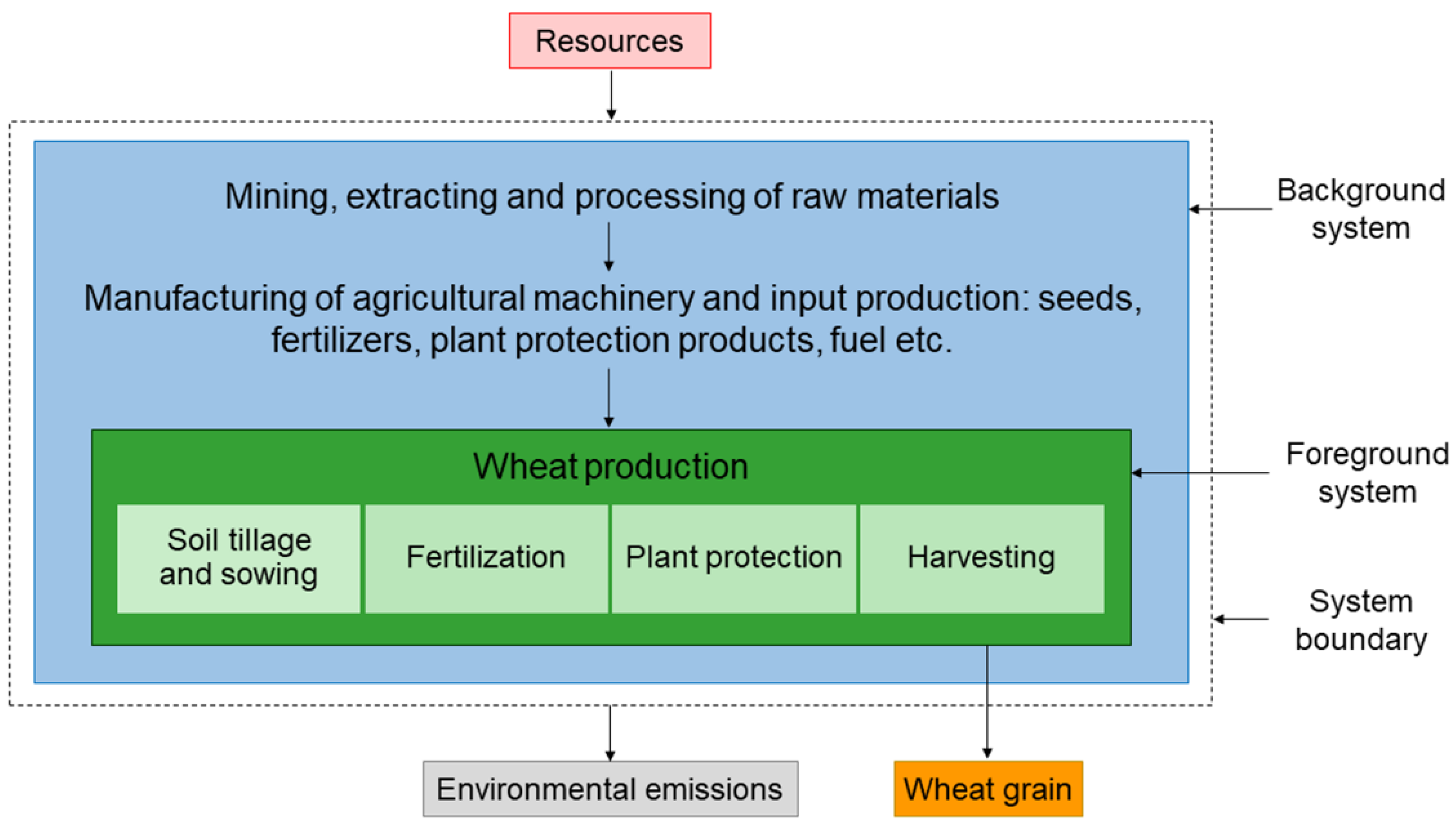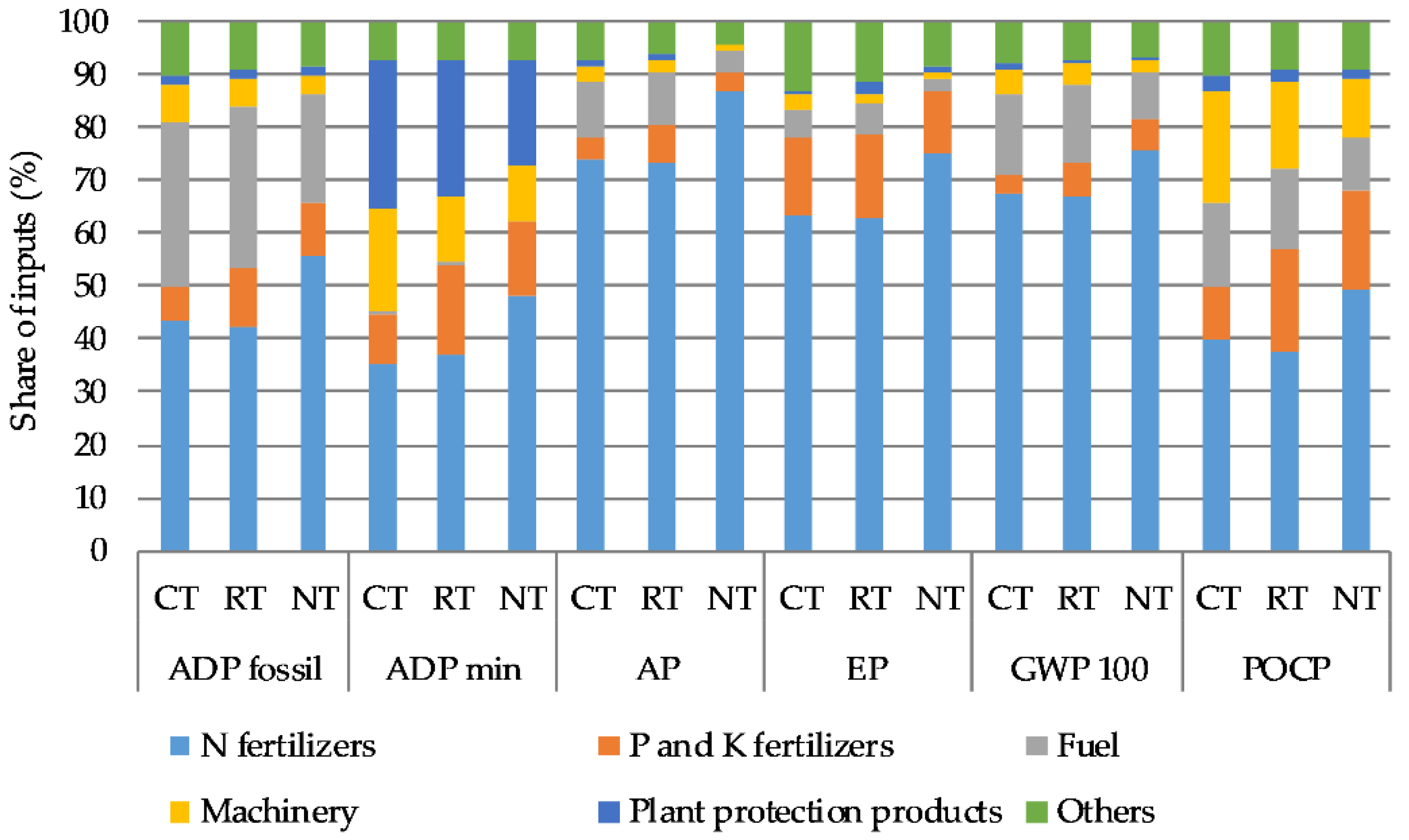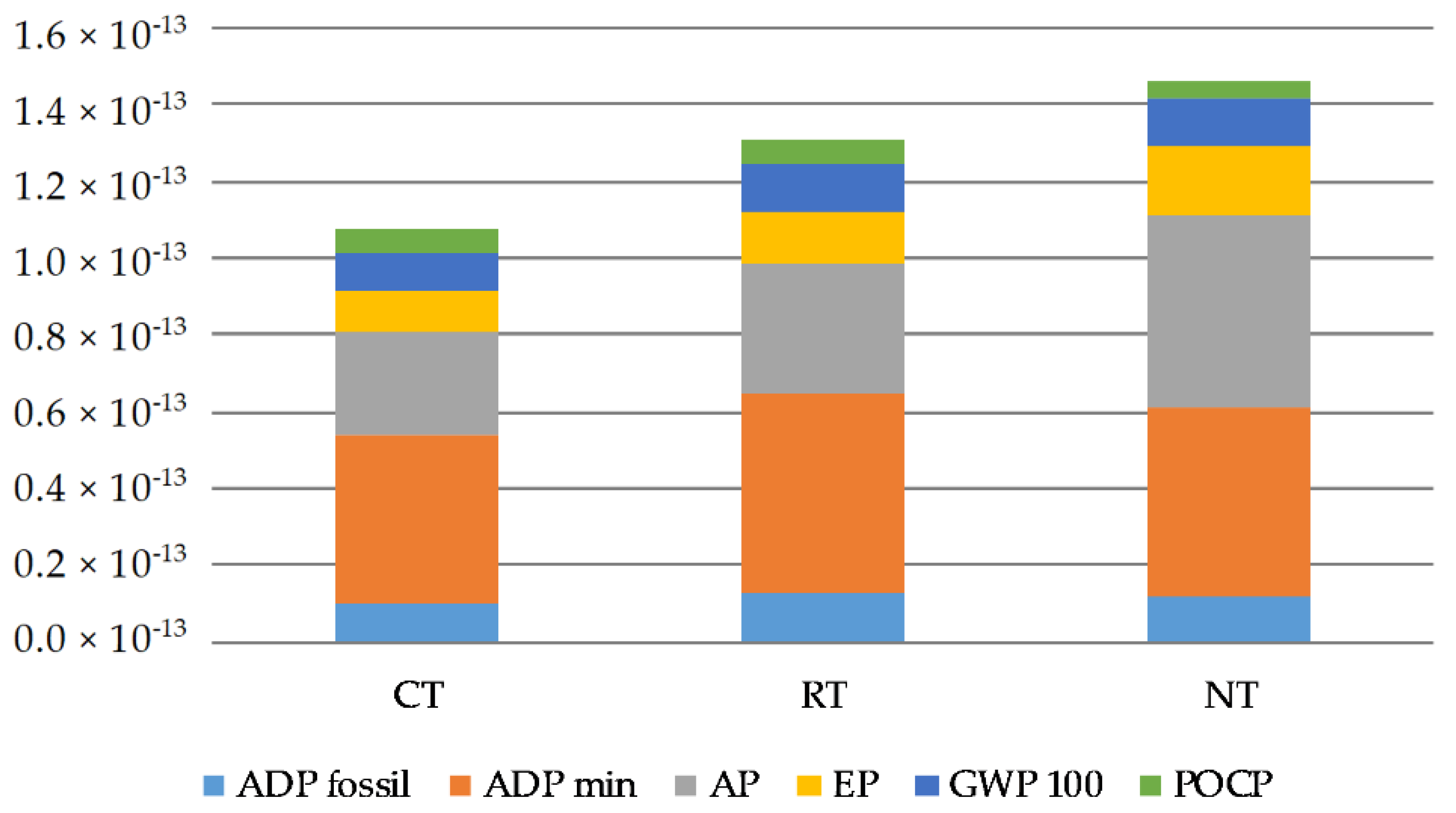Assessment of Environmental Burdens of Winter Wheat Production in Different Agrotechnical Systems
Abstract
1. Introduction
2. Materials and Methods
2.1. Study Site
2.2. Life Cycle Assessment (LCA) Methodology
2.2.1. Goal and Scope Definition
2.2.2. Inventory Analysis
2.2.3. Life Cycle Impact Assessment (LCIA)
- Icat—an impact category indicator;
- mi—the amount of the i-th substance used or emitted;
- CFcati—an impact category characterisation factor for the substance.
2.2.4. Interpretation
3. Results
4. Discussion
5. Conclusions
Author Contributions
Funding
Acknowledgments
Conflicts of Interest
References
- Shiferaw, B.; Smale, M.; Braun, H.-J.; Duveiller, E.; Reynolds, M.; Muricho, G. Crops that feed the world 10. Past successes and future challenges to the role played by wheat in global food security. Food Sec. 2013, 5, 291–317. [Google Scholar] [CrossRef]
- Food and Agriculture Organization of the United Nations (FAO). World Food and Agriculture. Statistical Pocketbook 2019; FAO: Rome, Italy, 2019; ISBN 978-92-5-131849-2. [Google Scholar]
- Statistics Poland. Production of Agricultural and Horticultural Crops in 2019; Statistics Poland: Warsaw, Poland, 2019. [Google Scholar]
- Eurostat. Available online: https://ec.europa.eu/eurostat/databrowser/view/tag00047/default/bar?lang=en (accessed on 10 May 2020).
- Eurostat. Agri-Environmental Indicator-Greenhouse Gas Emissions. Statistics Explained. 2019. Available online: https://ec.europa.eu/eurostat/statistics-explained/index.php?title=Agri-environmental_indicators (accessed on 10 December 2019).
- Morris, N.; Miller, P.; Orson, J.H.; Froud-Williams, R. The adoption of non-inversion tillage systems in the United Kingdom and the agronomic impact on soil, crops and the environment—A review. Soil Till. Res. 2010, 108, 1–15. [Google Scholar] [CrossRef]
- Romaneckas, K.; Avižienytė, D.; Bogužas, V.; Šarauskis, E.; Jasinskas, A.; Marks, M. Impact of tillage systems on chemical, biochemical and biological composition of soil. J. Elem. 2016, 21, 513–526. [Google Scholar] [CrossRef]
- Gajda, A.M.; Czyż, E.A.; Stanek-Tarkowska, J.; Furtak, K.M.; Grządziel, J. Effects of long-term tillage practices on the quality of soil under winter wheat. Plant Soil Environ. 2017, 63, 236–242. [Google Scholar] [CrossRef]
- Woźniak, A. Chemical properties and enzyme activity of soil as affected by tillage system and previous crop. Agriculture 2019, 9, 262. [Google Scholar] [CrossRef]
- Nunes, M.R.; Karlen, D.L.; Moorman, T.B. Tillage intensity effects on soil structure indicators—A US meta-analysis. Sustainability 2020, 12, 2071. [Google Scholar] [CrossRef]
- Pikuła, D. Environmental aspects of managing the organic matter in agriculture. Econ. Reg. Stud. 2015, 8, 98–112. [Google Scholar]
- European Environment Agency (EEA). Climate Change Adaptation in the Agriculture Sector in Europe. Available online: https://www.eea.europa.eu/publications/cc-adaptation-agriculture (accessed on 10 September 2019).
- Šimon, T.; Javurek, M.; Mikanová, O.; Vach, M. The influence of tillage systems on soil organic matter and soil hydrophobicity. Soil Till. Res. 2009, 105, 44–48. [Google Scholar] [CrossRef]
- Sapkota, T.B.; Mazzoncini, M.; Bàrberi, P.; Antichi, D.; Silvestri, N. Fifteen years of no till increase soil organic matter, microbial biomass and arthropod diversity in cover crop-based arable cropping systems. Agron. Sustain. Dev. 2012, 32, 853–863. [Google Scholar] [CrossRef]
- Małecka-Jankowiak, I.; Blecharczyk, A.; Swędrzyńska, D.; Sawińska, Z.; Piechota, T. The effect of long-term tillage systems on some soil properties and yield of pea (Pisum sativum L.). Acta Sci. Pol. Agricultura 2016, 15, 37–50. [Google Scholar]
- Holland, J.M. The environmental consequences of adopting conservation tillage in Europe: Reviewing the evidence. Agric. Ecosyst. Environ. 2004, 103, 1–25. [Google Scholar] [CrossRef]
- Busari, M.; Kukal, S.; Kaur, A.; Bhatt, R.; Dulazi, A. Conservation tillage impacts on soil, crop and the environment. Int. Soil Water Conserv. Res. 2015, 3, 119–129. [Google Scholar] [CrossRef]
- Haliniarz, M.; Gawęda, D.; Bujak, K.; Frant, M.; Kwiatkowski, C. Yield of winter wheat depending on the tillage system and level of mineral fertilization. Acta Sci. Pol. Agricultura 2013, 12, 59–72. [Google Scholar]
- Małecka, I.; Blecharczyk, A.; Sawińska, Z.; Swędrzyńska, D.; Piechota, T. Winter wheat yield and soil properties response to long-term non-inversion tillage. J. Agric. Sci. Tech. 2015, 17, 1571–1584. [Google Scholar]
- Panasiewicz, K.; Faligowska, A.; Szymańska, G.; Szukała, J.; Ratajczak, K.; Sulewska, H. The effect of various tillage systems on productivity of narrow-leaved lupin-winter wheat-winter triticale-winter barley rotation. Agronomy 2020, 10, 304. [Google Scholar] [CrossRef]
- Soane, B.; Ball, B.; Arvidsson, J.; Basch, G.; Moreno, F.; Roger-Estrade, J. No-till in northern, western and south western Europe: A review of problems and opportunities for crop production and the environment. Soil Till. Res. 2012, 118, 66–87. [Google Scholar] [CrossRef]
- Pittelkow, M.C.; Linquist, A.B.; Lundy, E.M.; Liang, X.; Groenigen, J.; Lee, J.; van Gestel, N.; Six, J.; Venterea, R.T.; van Kessel, C. When does no-till yield more? A global meta-analysis. Field Crops Res. 2015, 183, 156–168. [Google Scholar] [CrossRef]
- Caffrey, K.R.; Veal, M.V. Conducting an agricultural life cycle assessment: Challenges and perspectives. Sci. World J. 2013, 472431:1–472431:13. [Google Scholar] [CrossRef]
- Dijkman, T.J.; Basset-Mens, C.; Antón, A.; Nunez, M. LCA of food and agriculture. In Life Cycle Assessment: Theory and Pratice; Hauschild, M.Z., Rosenbaum, R.K., Olsen, S.I., Eds.; Springer International Publishing AG: Cham, Switzerland, 2018; pp. 723–754. [Google Scholar]
- Brentrup, F.; Küsters, J.; Kuhlmann, H.; Lammel, J. Environmental impact assessment of agricultural production systems using the life cycle assessment methodology: I. Theoretical concept of a LCA method tailored to crop production. Eur. J. Agron. 2004, 20, 247–264. [Google Scholar] [CrossRef]
- Hayashi, K.; Gaillard, G.; Nemecek, T. Life cycle assessment of agricultural production systems: Current issues and future perspectives. In Proceedings of the International Seminar on Technology Development for Good Agriculture Practice (GAP) in Asia and Oceania, Epochal Tsukuba, Japan, 25–26 October 2005; Hu, S.H., Bejosano-Gloria, C., Eds.; Food and Fertilizer Technology Center: Taipei, Taiwan, 2006; pp. 98–110. [Google Scholar]
- Holka, M.; Jankowiak, J.; Bieńkowski, J.F.; Dąbrowicz, R. Life cycle assessment (LCA) of winter wheat in an intensive crop production system in Wielkopolska region (Poland). Appl. Ecol. Environ. Res. 2016, 14, 535–545. [Google Scholar] [CrossRef]
- Syp, A.; Faber, A.; Borzęcka, M.; Osuch, D. Assessment of greenhouse gas emissions in winter wheat farms using data envelopment analysis approach. Pol. J. Environ. Stud. 2015, 24, 2197–2203. [Google Scholar] [CrossRef]
- Pishgar-Komleh, S.H.; Żyłowski, T.; Rozakis, S.; Kozyra, J. Efficiency under different methods for incorporating undesirable outputs in an LCA+DEA framework: A case study of winter wheat production in Poland. J. Environ. Manag. 2020, 260, 110138:1–110138:10. [Google Scholar] [CrossRef]
- Markuszewska, I. Intensification or extensification of Polish agriculture?—In searching of directions of changes. A case study: The North-Western Region of Poland. J. Agribus. Rural Dev. 2015, 1, 67–73. [Google Scholar] [CrossRef]
- International Organization for Standardization (ISO). ISO 14040:2006. Environmental Management–Life Cycle Assessment–Principles and Framework; International Organization for Standardization: Geneva, Switzerland, 2006. [Google Scholar]
- International Organization for Standardization (ISO). ISO 14044:2006. Environmental Management—Life Cycle Assessment—Requirements and Guidelines; International Organization for Standardization: Geneva, Switzerland, 2006. [Google Scholar]
- Ecoinvent Center Ecoinvent Database Website. Available online: http://www.ecoinvent.ch/ (accessed on 20 September 2019).
- European Environment Agency (EEA). EMEP/EEA Air Pollutant Emission Inventory Guidebook 2013; Publications Office of the European Union: Luxembourg, 2013; ISBN 978-92-9213-403-7. [Google Scholar]
- Intergovernmental Panel on Climate Change (IPCC). 2006 IPCC Guidelines for National Greenhouse Gas Inventories. Volume 2 Energy. Task Force on National Greenhouse Gas Inventories. Available online: http://www.ipcc-nggip.iges.or.jp/public/2006gl/vol2.html (accessed on 20 September 2019).
- Van Beek, C.L.; Brouwer, L.; Oenema, O. The use of farmgate balances and soil surface balances as estimator for nitrogen leaching to surface water. Nutr. Cycl. Agroecosyst 2003, 67, 233–244. [Google Scholar] [CrossRef]
- Dijkman, T.J.; Birkved, M.; Hauschild, M.Z. PestLCI 2.0: A second generation model for estimating emissions of pesticides from arable land in LCA. Int. J. Life Cycle Assess. 2012, 17, 973–986. [Google Scholar] [CrossRef]
- European Environment Agency (EEA). EMEP/EEA Air Pollutant Emission Inventory Guidebook 2016; Publications Office of the European Union: Luxembourg, 2016; ISBN 978-92-9213-806-6. [Google Scholar]
- Intergovernmental Panel on Climate Change (IPCC). Climate Change 2007: The Physical Science Basis. In Contribution of Working Group I to the Fourth Assessment Report of the Intergovernmental Panel on Climate Change; Solomon, S., Qin, D., Manning, M., Chen, Z., Marquis, M., Averyt, K.B., Tignor, M., Miller, H.L., Jr., Eds.; Cambridge University Press: Cambridge, UK; New York, NY, USA, 2007; p. 996. [Google Scholar]
- Van Oers, L.; De Koning, A.; Guinée, J.B.; Huppes, G. Abiotic Resource Depletion in LCA. Improving Characterisation Factors for Abiotic Resource Depletion as Recommended in the New Dutch LCA Handbook; RWS-DWW: Delft, the Netherlands, 2002; Available online: http://www.leidenuniv.nl/cml/ssp/projects/lca2/report_abiotic_depletion_web.pdf (accessed on 10 May 2020).
- Huijbregts, M.A.J.; Verkuijlen, S.W.E.; Heijungs, R.; Reijnders, L. Spatially explicit characterization of acidifying and eutrophying air pollution in life-cycle assessment. J. Ind. Ecol. 2001, 4, 75–92. [Google Scholar] [CrossRef]
- Andersson-Sköld, Y.; Grennfelt, P.; Pleijel, K. Photochemical ozone creation potentials: A study of different concepts. J. Air Waste Manag. Assoc. 1992, 42, 1152–1158. [Google Scholar] [CrossRef]
- Derwent, R.G.; Jenkin, M.E.; Saunders, S.M.; Pilling, M.J. Photochemical ozone creation potentials for organic compounds in Northwest Europe calculated with a master chemical mechanism. Atmos. Environ. 1998, 32, 2429–2441. [Google Scholar] [CrossRef]
- Guinée, J.B.; Gorrée, M.; Heijungs, R.; Huppes, G.; Kleijn, R.; de Koning, A.; van Oers, L.; Wegener Sleeswijk, A.; Suh, S.; Udo de Haes, H.A.; et al. Handbook on Life Cycle Assessment. Operational Guide to the ISO Standards. I: LCA in Perspective. IIa: Guide. IIb: Operational Annex. III: Scientific Background; Kluwer Academic Publishers: Dordrecht, the Netherlands, 2002. [Google Scholar]
- Sleeswijk, A.W.; van Oers, L.F.C.M.; Guinée, J.B.; Struijs, J.; Huijbregts, M.A.J. Normalisation in product life cycle assessment: An LCA of the global and European economic systems in the year 2000. Sci. Total Environ. 2008, 390, 227–240. [Google Scholar] [CrossRef]
- Achten, W.M.J.; Van Acker, K. EU-average impacts of wheat production. A meta-analysis of life cycle assessments. J. Ind. Ecol. 2015, 20, 132–144. [Google Scholar] [CrossRef]
- Charles, R.; Jolliet, O.; Gaillard, G.; Pellet, D. Environmental analysis of intensity level in wheat crop production using life cycle assessment. Agric. Ecosyst. Environ. 2006, 113, 216–225. [Google Scholar] [CrossRef]
- Sørensen, C.G.; Halberg, N.; Oudshoorn, F.W.; Petersen, B.M.; Dalgaard, R. Energy inputs and GHG emissions of tillage systems. Biosyst. Eng. 2014, 120, 2–14. [Google Scholar] [CrossRef]
- Baum, R.; Bieńkowski, J. Eco-efficiency in measuring the sustainable production of agricultural crops. Sustainability 2020, 12, 1418. [Google Scholar] [CrossRef]
- Aryal, J.P.; Sapkota, T.B.; Jat, M.L.; Bishnoi, D.K. On-farm economic and environmental impact of zero-tillage wheat: A case of North-West India. Exp. Agric. 2014, 51, 1–16. [Google Scholar] [CrossRef]
- Lu, X.; Lu, X.; Liao, Y. Conservation tillage increases carbon sequestration of winter wheat-summer maize farmland on Loess Plateau in China. PLoS ONE 2018, 13, e0199846:1–e0199846:16. [Google Scholar] [CrossRef]
- Memon, M.S.; Guo, J.; Tagar, A.A.; Perveen, N.; Ji, C.; Memon, S.A.; Memon, N. The effects of tillage and straw incorporation on soil organic carbon status, rice crop productivity, and sustainability in the rice-wheat cropping system of eastern China. Sustainability 2018, 10, 961. [Google Scholar] [CrossRef]
- Simmons, A.; Muir, S.; Brock, P.; Herridge, D. Life cycle assessment of grain cropping. In Proceedings of the 17th ASA Conference, Hobart, Australia, 21–24 September 2015; Acuña, T., Moeller, C., Parsons, D., Harrison, M., Eds.; ASA Inc.: Warragul, Australia, 2015; pp. 131–134. [Google Scholar]
- Yan, M.; Cheng, K.; Luo, T.; Yan, Y.; Pan, G.; Rees, R.M. Carbon footprint of grain crop production in China-based on farm survey data. J. Clean. Prod. 2015, 104, 130–138. [Google Scholar] [CrossRef]
- Romeiko, X.X. A comparative life cycle assessment of crop systems irrigated with the groundwater and reclaimed water in Northern China. Sustainability 2019, 11, 2743. [Google Scholar] [CrossRef]
- Brentrup, F. Life cycle assessment of crop production. In Green Technologies in Food Production and Processing; Boye, J.I., Arcand, Y., Eds.; Springer: Boston, MA, USA, 2012; pp. 61–82. ISBN 978-1-4614-1587-9. [Google Scholar]
- Fallahpour, F.; Aminghafouri, A.; Ghalegolab Behbahani, A.; Bannayan, M. The environmental impact assessment of wheat and barley production by using life cycle assessment (LCA) methodology. Environ. Dev. Sustain. 2012, 14, 979–992. [Google Scholar] [CrossRef]
- Tuomisto, H.; Hodge, I.; Riordan, P.; Macdonald, D. Comparing global warming potential, energy use and land use of organic, conventional and integrated winter wheat production. Ann. Appl. Biol. 2012, 161, 116–126. [Google Scholar] [CrossRef]
- Brock, P.; Madden, P.; Schwenke, G.; Herridge, D. Greenhouse gas emissions profile for 1 tonne of wheat produced in Central Zone (East) New South Wales: A life cycle assessment approach. Crop Pasture Sci. 2012, 63, 319–329. [Google Scholar] [CrossRef]
- Brentrup, F.; Küsters, J.; Lammel, J.; Kuhlmann, H. Impact assessment of abiotic resource consumption conceptual considerations. Int. J. Life Cycle Assess. 2002, 7, 301–307. [Google Scholar] [CrossRef]
- Brentrup, F.; Küsters, J.; Lammel, J.; Barraclough, P.; Kuhlmann, H. Environmental impact assessment of agricultural production systems using the life cycle assessment (LCA) methodology II. The application to N fertilizer use in winter wheat production systems. Eur. J. Agron. 2004, 20, 265–279. [Google Scholar] [CrossRef]
- Skowrońska, M.; Filipek, T. Life cycle assessment of fertilizers: A review. Int. Agrophysics 2014, 28, 101–110. [Google Scholar] [CrossRef]







| Farm Number | Tillage System | UAA (ha) | Voivodeship | District | Commune |
|---|---|---|---|---|---|
| 1 | CT | 7.84 | Wielkopolska | Kalisz | Ceków |
| 2 | CT | 73.06 | Wielkopolska | Kościan | Krzywiń |
| 3 | CT | 30.21 | Wielkopolska | Krotoszyn | Koźmin Wielkopolski |
| 4 | CT | 38.44 | Wielkopolska | Leszno | Rydzyna |
| 5 | CT | 26.84 | Wielkopolska | Wolsztyn | Siedlec |
| 6 | RT | 105.55 | Wielkopolska | Konin | Kleczew |
| 7 | RT | 98.69 | Wielkopolska | Międzychód | Międzychód |
| 8 | RT | 101.52 | Wielkopolska | Międzychód | Sieraków |
| 9 | RT | 18.53 | Wielkopolska | Ostrów | Nowe Skalmierzyce |
| 10 | RT | 156.33 | Wielkopolska | Września | Kołaczkowo |
| 11 | NT | 372.00 | Wielkopolska | Gostyń | Borek Wielkopolski |
| 12 | NT | 165.63 | Wielkopolska | Koło | Chodów |
| 13 | NT | 44.50 | Wielkopolska | Ostrów | Raszków |
| 14 | NT | 975.00 | Wielkopolska | Szamotuły | Szamotuły |
| 15 | NT | 51.00 | Wielkopolska | Wągrowiec | Wągrowiec |
| Tillage System | Tillage Practices |
|---|---|
| CT | Skimming, harrowing, ploughing to a depth of 25–30 cm, seedbed preparation with a cultivating aggregate, followed by the use of a sowing machine. |
| RT | Post-harvest tillage using implements such as a stubble cultivator or disc harrow to a depth of 10–20 cm, and the use of cultivating and sowing aggregate. |
| NT | Sowing directly into the untilled soil, which has retained the previous crop residues, using a direct seed drill. |
| Specification | Tillage System | ||
|---|---|---|---|
| CT | RT | NT | |
| Winter wheat sowing area, ha | 8.3 (2.3–21.0) | 21.6 (1.3–44.9) | 75.0 (2.0–260.0) |
| Grain wheat yield, Mg ha−1 | 7.6 (5.8–9.4) | 6.9 (5.4–9.4) | 6.6 (5.3–9.0) |
| N fertilization, kg N ha−1 | 117.6 (78.8–160.8) | 130.1 (66.0–214.4) | 147.2 (82.0–269.4) |
| P fertilization kg P2O5 ha−1 | 26.6 (0–46.0) | 48.0 (0–80.0) | 33.4 (0–60.0) |
| K fertilization, kg K2O ha−1 | 35.6 (0–60.0) | 99.3 (56.0–129.0) | 104.5 (0–287.0) |
| Herbicides, kg a.s. ha−1 | 1.32 (0.05–2.91) | 0.88 (0.03–2.52) | 0.52 (0.06–1.50) |
| Fungicides, kg a.s. ha−1 | 0.60 (0.01–1.23) | 0.63 (0.40–0.93) | 0.57 (0.22–0.95) |
| Insecticides, kg a.s. ha−1 | 0.06 (0–0.20) | 0.10 (0–0.20) | 0.04 (0–0.20) |
| Growth regulators, kg a.s. ha−1 | 0.05 (0–0.29) | 0.55 (0–1.45) | 0.30 (0–1.13) |
| Process | References |
|---|---|
| Production of seeds | [33] |
| Production of agrochemicals | [33] |
| Production and use of agricultural machinery | [33] |
| Use of mineral fertilizers | [34,35,36] |
| Use of plant protection products | [37] |
| Fuel combustion | [38] |
| Crop residue management | [39] |
| Impact Category Indicator | Abbreviation | Unit | Methodology | References |
|---|---|---|---|---|
| Abiotic depletion potential for fossil fuel | ADP fossil | MJ | CML 2001 | [40] |
| Abiotic depletion potential for minerals | ADP min | kg Sb eq. | CML 2001 | [40] |
| Acidification potential | AP | kg SO2 eq. | CML 2001 | [41] |
| Eutrophication potential | EP | kg PO4 eq. | CML 2001 | [41] |
| Global warming potential for time horizon of 100 years | GWP 100 | kg CO2 eq. | CML 2001 | [39] |
| Photochemical ozone creation potential | POCP | kg C2H4 eq. | CML 2001 | [42,43] |
| Impact Category Indicator | Tillage System | ||
|---|---|---|---|
| CT | RT | NT | |
| ADP fossil, MJ kg−1 | 2.17 | 2.73 | 2.48 |
| ADP min, kg Sb eq. kg−1 | 1.58 × 10−6 | 1.87 × 10−6 | 1.77 × 10−6 |
| AP, kg SO2 eq. kg−1 | 2.72 × 10−3 | 3.47 × 10−3 | 5.14 × 10−3 |
| EP, kg PO4 eq. kg−1 | 1.16 × 10−3 | 1.47 × 10−3 | 1.89 × 10−3 |
| GWP 100, kg CO2 eq. kg−1 | 0.31 | 0.39 | 0.40 |
| POCP, kg C2H4 eq. kg−1 | 5.19 × 10−5 | 6.73 × 10−5 | 6.19 × 10−5 |
© 2020 by the authors. Licensee MDPI, Basel, Switzerland. This article is an open access article distributed under the terms and conditions of the Creative Commons Attribution (CC BY) license (http://creativecommons.org/licenses/by/4.0/).
Share and Cite
Holka, M.; Bieńkowski, J. Assessment of Environmental Burdens of Winter Wheat Production in Different Agrotechnical Systems. Agronomy 2020, 10, 1303. https://doi.org/10.3390/agronomy10091303
Holka M, Bieńkowski J. Assessment of Environmental Burdens of Winter Wheat Production in Different Agrotechnical Systems. Agronomy. 2020; 10(9):1303. https://doi.org/10.3390/agronomy10091303
Chicago/Turabian StyleHolka, Małgorzata, and Jerzy Bieńkowski. 2020. "Assessment of Environmental Burdens of Winter Wheat Production in Different Agrotechnical Systems" Agronomy 10, no. 9: 1303. https://doi.org/10.3390/agronomy10091303
APA StyleHolka, M., & Bieńkowski, J. (2020). Assessment of Environmental Burdens of Winter Wheat Production in Different Agrotechnical Systems. Agronomy, 10(9), 1303. https://doi.org/10.3390/agronomy10091303





